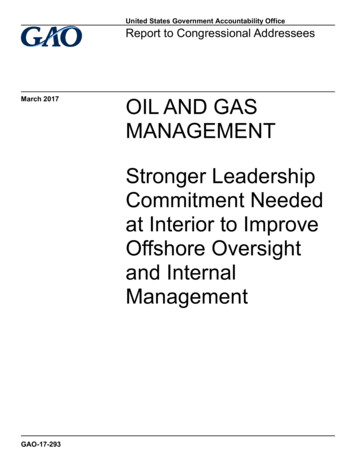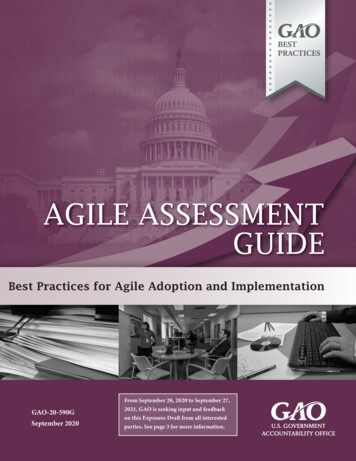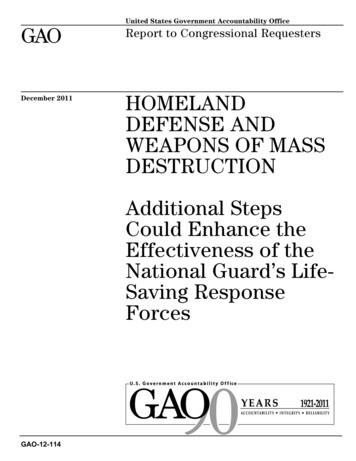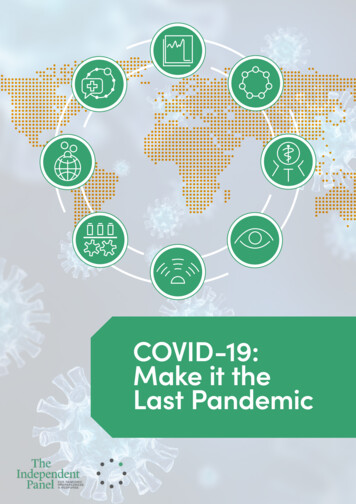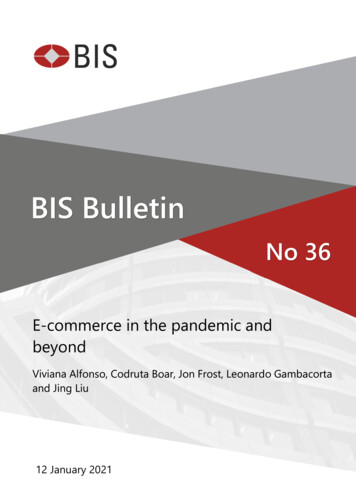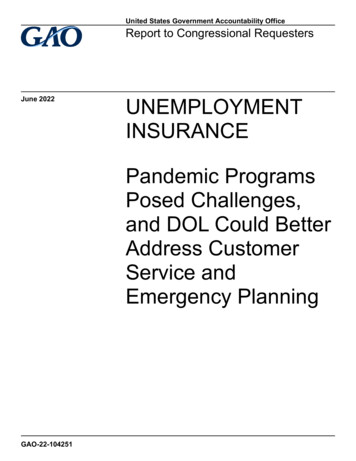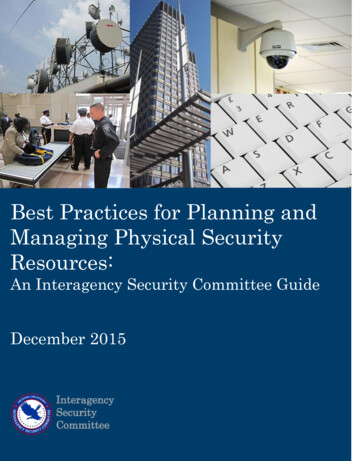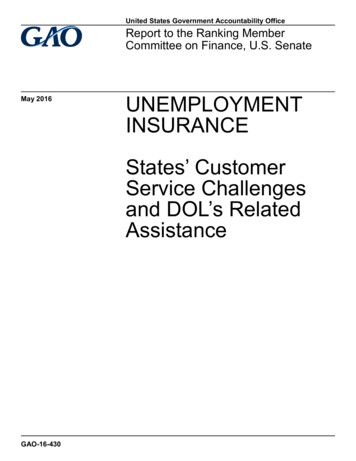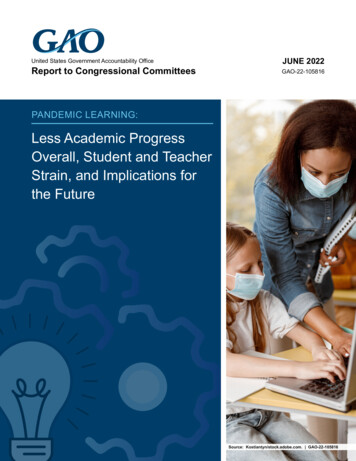
Transcription
United States Government Accountability OfficeReport to Congressional CommitteesJUNE 2022GAO-22-105816PANDEMIC LEARNING:Less Academic ProgressOverall, Student and TeacherStrain, and Implications forthe FutureSource: Kostiantyn/stock.adobe.com. GAO-22-105816
CONTENTSGAO Highlights. iiiLetter. ivScope and Methodology.ivPandemic Instructional Models.viSECTION 1: The Pandemic’s Effect on Academic Progress. 1About Half of Teachers Had More Students Who Started the 2020-21School Year Behind . 2While More Teachers Had Students Who Made Less AcademicProgress during the 2020-21 School Year, Some Had Students Who Excelled. 3Many Teachers Had Students Who Ended the 2020-21 School YearBehind, Regardless of Learning Model. 7SECTION 2: Implications Moving Forward, and Educators’ andParents’ Reflections on How to Support Students. 9Students. 9Teachers.11Strategies and Resources. 12List of Committees. 15APPENDIX I: GAO Related Products. 16APPENDIX II: GAO Contact and Staff Acknowledgments. 17CopyrightThis is a work of the U.S. government and is not subject to copyright protection in the United States. The published product may bereproduced and distributed in its entirety without further permission from GAO. However, because this work may contain copyrightedimages or other material, permission from the copyright holder may be necessary if you wish to reproduce this material separately.Page iiGAO-22-105816 Pandemic Learning Loss
GAO HighlightsHighlightsPANDEMIC LEARNINGHighlights of GAO-22-105816, a report tocongressional committeesLess Academic Progress Overall, Student andTeacher Strain, and Implications for the FutureWhy GAO Did This StudyWhat GAO FoundThe COVID-19 pandemic disruptedlearning for millions of students,educators, and families. Its effectscontinue to reverberate across thenation and produce challenges forschools that will likely be felt foryears to come. In many respects, the2020-21 school year offers insightsand lessons on the struggles andsuccesses that schools, educators,and parents faced.Compared to a typical school year, teachers reportedthat more of their students started the 2020-21 schoolyear behind and made less academic progress,according to GAO’s generalizable survey of K-12public school teachers. Teachers also reported thatmany students ended the year behind grade levelexpectations (see figure). Educators and parents alsoshared their insights and experiences about studentstruggles and learning loss during the year.The CARES Act includes a provisionfor GAO to report on its ongoingCOVID-19 monitoring and oversightefforts.This report, the third in a seriesof three reports, examines (1) theeffect of the pandemic on academicprogress, and (2) implications,and strategies and resourcesidentified by educators and parentsto address ongoing challenges orfuture learning disruptions.To address these objectives, GAOcontracted with Gallup to (1) conducta nationally representative surveyof elementary and secondary publicschool teachers and (2) arrangevirtual discussion groups withteachers, principals, and parents ofK-12 students. The overall responserate was 8.2 percent (using theAmerican Association for PublicOpinion Research’s response rate3, which accounts for the estimatedeligibility rate of non-respondents).GAO analyzed the resultingsurvey data and discussion groupinformation. GAO estimated marginsof error at the 95 percent confidencelevel. To view the first two reports,see GAO-22-104487 and GAO-22105815. To view the supplementonline, click on GAO-22-105817.View GAO-22-105816. For moreinformation, contact JacquelineM. Nowicki at (617) 788-0580 ornowickij@gao.gov.GAO estimated that about half of teachers (52percent) had more of their students start the 202021 school year behind compared to a typical schoolyear, and that this affected younger students morethan older students. Further, nearly two-thirds ofteachers (64 percent) had more students makeless academic progress than in a typical schoolyear. These issues occurred across all grades andinstructional models, and were more pronounced insome than others. For example, between 68 and 72percent of teachers of older students or in virtual orhybrid environments had students who made lessprogress than is typical, compared to other gradesand learning models. Finally, 45 percent of teachershad at least half of their students end the yearbehind grade level.Educators and parents did note, however, that somestudents excelled despite the strain of the pandemic.Factors associated with such success includedflexibility to work at their own pace and strongfamilial support.The pandemic continues to take a toll on students’and teachers’ well-being. The trauma of the last 2years has profoundly affected many students andteachers, some of whom lost parents or familymembers. As our teacher survey, educator andparent discussion groups, and other researchhas shown, this trauma and pandemic-associatedschooling disruptions disproportionately harmedvulnerable students and contributed to growingdisparities between student populations. Further,after 2 years of challenging working conditions,teachers are confronting burnout and recent surveysindicate that many are thinking of leaving their jobs.To help address some of these ongoing challengesas well as inform thinking about managing futurelearning disruptions, educators and parents identifiedstrategies such as providing mental health servicesfor students.JUNE 2022Academic Progress duringSchool Year 2020-2152%of teachersSEPT.had more students start the2020-21 school year behindcompared to a typicalpre-pandemic year,64%of teachersFEB.had more students who madeless academic progress than in atypical pre-pandemic year,45%JUNof teachers.had at least half theirstudents end the year behind.Source: GAO analysis of survey of K-12 public schoolSource: GAO analysis of survey of K-12teachers. GAO-22-105816public school teachers. GAO-22-105816Note: The margin of error for allpercentages was less than or equal to /- 8percent at the 95 percent confidence level.The survey asked teachers how many oftheir students were behind grade level ormade less academic progress. We did notdefine “behind” or “academic progress”as we wanted to obtain teachers’ overallobservations of their students.UNITED STATES GOVERNMENT ACCOUNTABILITY OFFICE
LetterUNITED STATES GOVERNMENT ACCOUNTABILITY OFFICE441 G St. N.W.Washington, DC 20548June 8, 2022Congressional CommitteesFor over 2 years, the COVID-19 pandemic has disrupted learning for millions of students, educators, and families.Its effects continue to reverberate across the nation and schools will likely feel these effects for years to come. Manyschools and districts continued virtual learning for much of the 2020-21 school year. Recognizing the challenges ofvirtual learning, they continually re-evaluated trade-offs between how best to educate students while minimizing thespread of COVID-19 based on health and safety indicators in their communities. As schools and districts struggled tooperate amid uncertainty and difficult circumstances, students were profoundly affected. In many respects, the 2020-21school year offers important insights into the struggles and successes students, educators, and parents faced.The CARES Act includes a provision for GAO to report on its ongoing monitoring and oversight efforts related to theCOVID-19 pandemic.1 As part of our body of work to understand the impact of COVID-19 on public K-12 education, weare issuing a series of reports in the spring of 2022 that highlight key findings from our nationally generalizable surveyof general education teachers and discussion groups with teachers, principals, and parents. Our first report describedobstacles to learning and strategies to mitigate learning loss that teachers found helped more or fewer students.2 Oursecond report focused on pandemic learning loss among three vulnerable populations—high-poverty, English learner,and kindergarten through second grade students—and described obstacles to learning as well as strategies to mitigatelearning loss teachers used with these students.3 This third and final report in this series on pandemic learning includestwo sections: the effect on academic progress, and implications, and strategies and resources identified by educators and parents to address ongoing challenges orfuture learning disruptions.Scope and MethodologyGAO contracted with Gallup to (1) conduct a nationally representative survey of elementary and secondary publicschool teachers between June 18 and July 9, 2021 and (2) arrange virtual discussion groups with teachers, principals,and parents. Our survey focused on general education teachers at the elementary, middle, and high school levels.41Pub. L. No. 116-136, § 19010, 134 Stat. 281, 579-81 (2020).GAO, Pandemic Learning: As Students Struggled to Learn, Teachers Reported Few Strategies as Particularly Helpful to Mitigate Learning Loss,GAO-22-104487 (Washington, D.C.: May 10, 2022).2We also issued a supplement with technical materials related to the three reports in the pandemic learning loss series issuing in May and June 2022:GAO, Pandemic Learning: Technical Materials for Teacher Survey and Discussion Groups with Public K-12 School Principals, Teachers, and Parents,GAO-22-105817 (Washington, D.C.: May 10, 2022).For more information on why we selected these populations for in depth analysis see GAO, Pandemic Learning: Teachers Reported Many Obstaclesfor High-Poverty Students and English Learners As Well As Some Mitigating Strategies, GAO-22-105815 (Washington, D.C.: May 31, 2022).3In addition, we recently issued related work on students who were unaccounted for in school year 2020-21. See GAO, K-12 Education: An Estimated1.1 Million Teachers Nationwide Had At Least One Student Who Never Showed Up for Class in the 2020-21 School Year, GAO-22-104581(Washington, D.C.: Mar. 23, 2022).We surveyed general education teachers who work in a public school and taught a core subject. For the purpose of this survey, core subjectsincluded: elementary school, math, science, computer science/information technology, English/language arts/reading/writing, social studies andworld/foreign languages or English language learning. For this work, we use the terms elementary, middle, and high school to refer to those teachingin grades K-5, 6-8, and 9-12, respectively.4Page ivGAO-22-105816 Pandemic Learning Loss
The survey asked teachers about their instructional models, adultsupport provided to their students, difficulties their students faced,their students’ academic progress, strategies they used to mitigatelearning loss, and the extent to which their students were engaged inlearning, among other topics.5 The initial sample was selected from twosources: the Gallup Panel, a probability based panel of U.S. adults, anda national list of teachers. The responses achieved our margin of errortargets for key subgroups by location, participation in free or reducedprice lunch (FRPL) programs, grade level, and percentage of Englishlearners. They were weighted to minimize bias independently for eachsource and for the sources combined. All estimates in this report havea margin of error less than or equal to /- 10 percent at the 95 percentconfidence level.Q&AQUESTION BOXWhat is learning loss?For the purposes of this report,learning loss means the loss orWe analyzed the survey responses of 2,862 teachers, which arereversal of knowledge or skills asgeneralizable to the population of all K-12 general education publicwell as forgone learning, which isschool teachers in the U.S.6 This analysis included disaggregation forthe learning that would haveeach key subgroup. We also developed a series of statistical models tooccurred under typicaldescribe the associations between teachers’ use of various strategiescircumstances. Learning loss mayto address learning loss and teachers’ perceived effectiveness of theaccumulate over time, particularly ifstrategies. Our models estimated the probability teachers’ reports thata student misses a lot of classes.“about half or more” of their students “improved their academicSource: GAO. GAO-22-105816progress” differed by instructional model. We grouped responses toeach question, in order to increase the sample sizes. We estimatedthese probabilities separately by grade level, in-person or hybrid andvirtual instructional models, and a three-way categorization of the school’s FRPL participation. We limited the surveyrespondents to those who responded to all relevant questions—a sub-sample that could vary across learning strategies.To gain further insight into the topics covered in the survey, we held 18 virtual discussion groups with public schoolteachers (six groups), parents of students (six groups), and principals (six groups) between June 29 and July 14, 2021.7We contracted with Gallup to recruit and arrange the K-12 public school groups. In total, Gallup segmented participantcategory (teachers, parents, and principals) based on their school’s geographic location (urban, suburban, or rural),with two groups for each participant type and location. Teachers participating in the groups had also responded toMany survey questions asked teachers to reflect on their experiences teaching virtually, in-person, or in a hybrid model. Teachers were instructedto answer these questions based on how their students learned for the majority of the year. Teachers who indicated they worked simultaneouslywith students learning fully in person and students learning fully virtually were randomly assigned to answer either the questions about teaching in avirtual environment or in person.5Our survey results are based on the responses of 2,862 teachers who met our eligibility criteria of public school general education teachers of coresubjects–selected from an initial sample of 45,792 teachers. The initial sample was selected from the Gallup Panel, a probability based panel ofU.S. adults, and a national list of teachers. The overall response rate was 8.2 percent (using the American Association for Public Opinion Research’sresponse rate 3, which accounts for the estimated eligibility rate of non-respondents). Estimates for subpopulations of interest had margins of errorranging from plus or minus 2.9 to 7.2 percent, although margins for individual questions varied depending upon the number of responses. Gallupadjusted the survey weights to account for potential nonresponse bias by accounting for relevant school characteristics for non-respondents andre-weighting (post-stratifying) the sample to match the number and regional distribution of teachers and teacher demographics such as age, sex, andrace. Weighting information came from the National Center for Education Statistics National Teacher and Principal Survey for 2017-2018. Based onthe survey and weighting adjustment methods used, we determined that estimates from this survey are generalizable to the population of U.S. publicK-12 general education teachers and are sufficiently reliable for the purposes of our report.6After completing the survey, teachers answered additional screening questions to determine their eligibility, interest, and availability to participate inour discussion groups. In addition, to respond to a provision in the conference report accompanying the National Defense Authorization Act of FiscalYear 2021 for GAO to examine virtual learning in Department of Defense Education Activity (DODEA) schools, we held two additional discussiongroups–one with DODEA teachers and one with parents of students in DODEA schools. For the DODEA discussion groups, we selected a nongeneralizable sample from DODEA’s Southeast district in the U.S., which had the highest percentage of stateside students in full-time virtual statusas of October 2020. To solicit participants for our discussion groups, we asked DODEA to send an email to teachers and parents in that district toinform them of our request. We considered five factors in selecting participants: (1) military installation within the Southeast district, (2) grade levelsteachers taught or grade level students were in, (3) subjects teachers taught, (4) gender of teachers and parents, and (5) race or ethnicity of teachersand parents. The findings from those two discussion groups are incorporated into our first pandemic learning loss report (see GAO-22-104487).7Page vGAO-22-105816 Pandemic Learning Loss
our generalizable teacher survey. GAO moderators structured and guided the discussions using a standardized list ofquestions to encourage participants to share their thoughts and experiences on students’ learning during school year2020-21 and on strategies used to mitigate learning loss. We developed discussion guides tailored to each stakeholdergroup (teachers, principals, and parents) without Gallup’s input. Prior to conducting any of the discussion groups withparticipants recruited by Gallup, we pretested our discussion guide with one teacher, two parents, and two principals. Toaccommodate the schedules of participants, each discussion group was held by video conference in the evening for onehour. The contractor also created a written transcript of each group. To select discussion group comments for the report,we first analyzed and coded the transcripts from these discussion groups for common themes among the groups. We thencompared these themes with our survey results to identify comments that were illustrative of the key themes across thesurvey and discussion group analyses. Comments, information, and views obtained from these discussion groups are notgeneralizable to other educators and parents.8Additional technical details about our scope and methodology are provided in GAO-22-105817, which offers technicalsupplementary material for all of our pandemic learning loss work issuing in May and June 2022. The materialincludes information such as survey terminology, the survey’s sample frame, margin of error and minimum sample sizerequirements, sample weighting, analysis approach, regression modeling, and discussion group recruitment and logistics.It also includes a copy of the survey instrument and survey results in aggregate for all closed-ended questions.We conducted this performance audit from August 2020 to June 2022 in accordance with generally accepted governmentauditing standards. Those standards require that we plan and perform the audit to obtain sufficient, appropriate evidenceto provide a reasonable basis for our findings and conclusions based on our audit objectives. We believe that theevidence obtained provides a reasonable basis for our findings and conclusions based on our audit objectives.Pandemic Instructional ModelsThroughout the 2020-21 school year, teachers, administrators, and policymakers were continually challenged to makedecisions about whether to keep schools open for in-person learning, close their school buildings (completely or on certaindays) and revert to virtual instruction, or use some combination of the two. In our nationally generalizable survey, weasked teachers to identify which of the following four models they taught in for the majority of the 2020-21 school year.9 In-person: teaching and learning occur in the same classroom. Virtual: teaching and learning occur via information technology (hardware and software), including video or audioconferencing and document sharing; could be supplemented with printed assignments and could be synchronous(real time) or asynchronous (accessed at any time). Hybrid: teaching and learning occur in person on certain days of the week and virtually on other days. Mixed: teachers present lessons simultaneously to students learning in person and to those learning virtually. (Theseteachers were randomly assigned to answer some survey questions about teaching in either a virtual environment orin-person.)We similarly analyzed teacher responses to our open-ended survey questions to select comments that were illustrative of key themes. We defined acommon theme as one identified in 20 separate teacher survey responses. These comments are not generalizable to other teachers.8Our analyses are not designed to estimate causal effects of particular learning models. We do not address, assess, or form conclusions about thehealth and safety measures taken by schools, districts, or states, including decisions to use any particular mode of instruction, in this body of work.Instead, we focus on how, in retrospect, these different instructional models related to students’ learning.9Page viGAO-22-105816 Pandemic Learning Loss
SECTION 1: The Pandemic’s Effect on Academic ProgressPANDEMIC LEARNINGSection1THE PANDEMIC’S EFFECTon Academic ProgressMany Students Struggled In School and Experienced Learning LossBased on our nationally generalizable survey, we estimate that, compared to a typical year,teachers had more students start the 2020-21 school year behind and make less academicprogress. Further, almost all teachers had students who ended the year behind (see figurebelow).10 Educators and parents in our discussion groups, who have first-hand insights into thechallenges students faced, described having concerns about the learning loss their students andchildren experienced.Keep in MindThe findings in this section are the result of our nationwide survey of K-12 teachers anddiscussion groups with teachers, principals, and parents and reflect their experiences during the2020-21 school year. When we refer to a “virtual environment”, we mean one in which studentsspent the majority of the year learning remotely. Similarly, “in person” means when students spentthe majority of the year learning in the classroom and “hybrid” refers to an environment in whichstudents spent some days learning remotely and others in the classroom. We also defined a“typical school year” as a recent school year prior to the pandemic. Differences in the responsesbetween virtual and in-person environments could reflect the instructional setting as well as otherfactors that we did not measure, such as school resources or certain student characteristics. (Wedid not design our analysis to estimate the causal effects of the environment.)Academic Progress duringSchool Year 2020-2152%of teachersSEPT.had more students start the 2020-21school year behind compared to atypical pre-pandemic year,64%of teachersFEB.had more students who made lessacademic progress than in a typicalpre-pandemic year,45%of teachersJUN.had at least half theirstudents end the year behind.Source: GAOanalysisof surveyof K-12 ofpublicschoolteachers. GAO-22-105816Source:GAOanalysisof surveyK-12publicschoolteachers. GAO-22-105816Note: The margin of error for all percentages was less than or equal to /- 8 percent at the 95 percent confidence level. The survey asked teachers howmany of their students were behind grade level or made less academic progress. We did not define “behind” or “academic progress” as we wanted toobtain teachers’ overall observations of their students.The survey asked teachers how many of their students were behind grade level. We did not define “behind” as we wanted to obtain teachers’overall observations of their students.10Page 1Pandemic Learning GAO-22-105816
SECTION 1 THE PANDEMIC’S EFFECT ON ACADEMIC PROGRESSAbout Half of Teachers Had MoreStudents Who Started the 2020-21School Year BehindWhat We HeardSource: GAO . GAO-22-105816Teachers began the 2020-21 school year with the addedchallenge of addressing learning loss resulting from thepandemic-related disruptions and closures from the prior schoolyear. We estimate that about half of teachers (52 percent) hadmore students who were behind at the beginning of the 202021 school year compared to a typical year.11 Further, thoseteaching K-2 and 3-8 had more students start the year behindthan did those teaching grades 9-12 (see figure below).Estimated Percentage of Teachers Who Had MoreStudents Who Started Behind“The thing I noticed [when] those little kiddos[came back into the actual classroom] is everysingle one of them no matter how advanced theywere at the end of the last school year, everysingle one of them came back way behind[.]”– Suburban Teacher“[W]e were in person for the majority of theyear but we felt that a lot of the kids were behind coming into the year. So we did somePublic K-12 Teachers by Grade Level, School Year 2020-21Compared to a Typical Pre-pandemic School Yearafter school help which bridged the gaps a littlePercentI still don’t think it was enough.100bit between some of the struggling students. But”– Rural TeacherSource: Discussion groups with public K-12 schoolteachers. GAO-22-105816806055Note: The selected comments reflect themesdiscussed by teachers in GAO discussion groupsand are not generalizable.574052%All teachers39200K-2*3-8*Grades9-12Source: GAO analysis of survey of K-12 public school teachers. GAO-22-105816Note: *There was no significant statistical difference between K-2 and 3-8. Themargin of error for all percentages was less than or equal to /- 8 percent atthe 95 percent confidence level. The survey asked teachers how many of theirstudents were behind grade level. We did not define “academic progress” aswe wanted to obtain teachers’ overall observations of their students.When analyzing the percent of public K-12 teachers who had more studentswho started behind compared to a typical school year the data were compiledinto three groups (less, about the same, and more), instead of two groups(less and about the same or more).11Page 2GAO-22-105816 Pandemic Learning Loss
SECTION 1 THE PANDEMIC’S EFFECT ON ACADEMIC PROGRESSWhile More Teachers Had Students WhoMade Less Academic Progress during the2020-21 School Year, Some Had StudentsWho ExcelledWhat We HeardSource: GAO . GAO-22-105816The majority of teachers (an estimated 64 percent) had morestudents who made less academic progress across all gradelevels and instructional models compared to a typical schoolyear. Teachers of older students more commonly had studentswho made less progress overall (see figure below).Estimated Percentage of Teachers Who Had Students WhoMade Less Academic Progress by Grade LevelPublic K-12 Teachers, School Year 2020-21 Compared to aTypical Pre-pandemic School Year“I just felt like compared to their grade levelsthe material was very much dumbed down sothat they would, I guess, learn it either throughZoom [o]r to make it easier for everybody. Butit was just not the quality of education that Iexpected.“”– Urban ParentI have students at my school [that] didn’treceive any science at all the entire year PercentThe teachers weren’t teaching science in100the classroom and the science teacher wasdedicated to fourth and fifth grade.A goodswath of my kids learned and kids at my school80learned less than half of what they should.72605862”– Urban Teacher64%All teachers“Teaching older students in high school, mostof the learning loss was from [students having]40to work to support their family or they had towatch younger siblings And so learning lossbasically came from outside forces from the20situations that those families would be in.”– Rural Teacher0K-2*3-8*Grades9-12Source: GAO analysis of survey of K-12 public school teachers. GAO-22-105816Source: GAO analysis of survey of K-12 public school teachers. GAO-22-105816Note: *There was no significant statistical difference between K-2 and 3-8.The margin of error for all percentages was less than or equal to /- 7percent at the 95 percent confidence level. The survey asked teachers howmany of their students made less academic progress. We did not define“academic progress” as we wanted to obtain teachers’ overall observationsof their students.Page 3Source: Discussion groups with teachers and parentsof students in public K-12 schools. GAO-22-105816Note: The selected comments reflect themesdiscussed by teachers and parents in GAOdiscussion groups and are not generalizable.GAO-22-105816 Pandemic Learning Loss
SECTION 1 THE PANDEMIC’S EFFECT ON ACADEMIC PROGRESSWhile More Teachers Had Students WhoMade Less Academic Progress during the2020-21 School Year, Some Had StudentsWho Excelled (continued)What We HeardSource: GAO . GAO-22-105816Having students who made less progress was more commonamong teachers in virtual and hybrid models (see figure below).Estimated Percentage of Teachers Who Had Students WhoMade Less Academic Progress by Instructional ModelPu
2 GAO, Pandemic Learning: As Students Struggled to Learn, Teachers Reported Few Strategies as Particularly Helpful to Mitigate Learning Loss, GAO-22-104487 (Washington, D.C.: May 10, 2022). We also issued a supplement with technical materials related to the three reports in the pandemic learning loss series issuing in May and June 2022:


